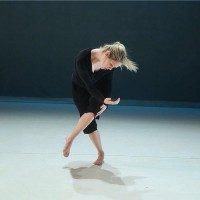Early in the introduction of her memoir Dancing in Blackness, Dr. Halifu Osumare offers her definition of Black dance as “…the individual and collective dances of any genre performed by black peoples anywhere in the world” (p. 10).* The subsequent six chapters of the autobiography unfold within the context of this definition, weaving personal stories, journal excerpts, and historical accounts together in a forthright and assured narrative voice. In the foreword for Dancing in Blackness, Brenda Dixon Gottschild writes that Osumare—a dancer, choreographer, arts administrator, scholar, and educator—“put dance on the map, in the service of social change” during the Black Arts Movement of the 60’s and 70’s (xiii).
Each chapter of Dancing in Blackness takes me on a geographical journey, beginning with Osumare’s early dance education in the San Francisco Bay Area in the 60’s. Born Janis Miller, Osumare describes her years as an undergraduate student at San Francisco State University. She becomes philosophically connected with the Black Arts Movement during this time, instilling in her a sense of activism through dance. Her account of the Long Hot Summer of 1967 feels especially significant right now, during national and international protests calling for an end to systematic police brutality against Black people. Wanting to understand what she refers to as the “fluid constant” of her Blackness outside of the context of a racist America, Osumare leaves for Europe, travelling first to Morocco. Next, she describes a three-year span working, dancing, and teaching in Barcelona, Paris, Amsterdam, Copenhagen, and Stockholm.
Osumare is skilled at simultaneously balancing context for her own personal story with a larger narrative of Black identity. Sections of the second chapter outlining the historical treatment of Black women in Europe are important additions to the memoir; the histories of Josephine Baker and Saartjie Baartman underscore Osumare’s own experience with being exoticized by European society. She finds “blackness as a selling point” in gaining employment while in Europe, which, although a departure from the American brand of racism, still exposes deeply held stereotypes about Black people (p. 50). Through several uncomfortable moments—a go-go dancing gig where she has to dance in a cage stands out in my mind— Osumare’s narration of her experiences are straight to the point: a testament to the conviction she carries for her mission, as she refers to it, of expanding and uplifting Black dance in its many forms.
In her return to America, Osumare first lands in Boston where she begins to expand her choreographic voice, and eventually relocates to New York after an invitation by Rod Rodgers to perform in his company. After leaving New York with her partner at the time, Osumare returns to the Oakland area of California. In a pivotal moment during the fourth chapter, famous American playwright Ntozake Shange gifts “Janis Miller” the name Halifu Osumare. With her new moniker, she creates her landmark choreographic work, The Evolution of Black Dance, during this time. She would give the performance/lecture/demonstration in many different circumstances and iterations over the next years.
Around the time that Osumare meets her first husband Kimathi, she travels for an extended stay in Ghana to study local dance forms. This portion of the book stood out to me; Osumare’s stories of learning and witnessing social, spiritual, and theatrical dance forms are interwoven with the history of Ghana’s sociopolitical relationship with dance and music. She describes in detail many dance and music traditions, and, in journal excerpts, what it feels like to be an African American visiting different countries in Africa. Osumare uses dance to connect to communities and traditions in a deeply embodied way, a testament to her strongly held belief that “dance is life, and life is dance.”
The spirit of community guides Osumare into her next journey upon her return to Oakland. Her focus shifts to include arts administration, as she and her husband acquire and transform Everybody’s Dance Studio, now called Malonga Casquelourd Arts Center, into one of the leading dance arts organizations in the area. Osumare’s involvement in the 1983 Dance Black America presented by BAM, the Katherine Dunham Residency that she organizes as Acting Director of the Dance Division for the Committee on Black Performing Arts at Stanford University, and her commission by the United States Information Agency to work with the Kwacha Cultural Troupe in Malawi are among countless notable accomplishments she covers in the last chapter of her book.
One thing that stands out is the emphasis that Osumare puts on the role that the media has on elevating Black dance in all its forms. She makes it clear that newspaper and television coverage was essential to the success of her many different projects. Reading this, I know that many arts organizations, including this publication, do not do enough to build up Black dance. This desperately needs to change.
Despite being a memoir, Dancing in Blackness is not the story of a single life. Osumare’s headstrong individuality and persistence is evident, but the real magic of this book is the way that she intertwines the stories of other important Black histories and artists. Osumare eschews essentialism in the contribution of Black artists to American modern dance by highlighting Black artists that create “within and without black cultural traditions” (p. 83). I get the sense that “dancing” in the title has a double meaning; Osumare’s idea of Blackness as a fluid constant suggests an ever-changing movement of context for Black folks, and that all of the names she invokes represent tiny facets of this idea.
*Spelling, punctuation, and capitalization in quotations are reproduced here as they are in the text.
Dr. Halifu Osumare, Dancing in Blackness. Gainesville, Florida: University Press of Florida, 2018.






